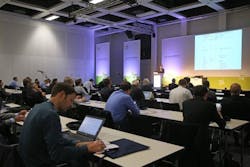micro photonics 2016: A new congress and trade fair on biophotonics and microoptics
Image. At the micro photonics 2016 Opening & Plenary Session I, Francesco Baldini, Istituto di Fisica Applicata Nello Carrara, Florence, Italy, addressed the audience. (Courtesy Messe Berlin)
A new photonics congress debuted in Berlin on October 11, with scientific tracks on biophotonics and micro/nanophotonics. The congress was connected with a trade fair featuring an extensive three-day program supported by the European Photonics Industry Consortium (EPIC) and several local organizations.
Exhibitors and visitors both praised the intense technical atmosphere and excellent networking. The EPIC TechWatch program included about 70 presentations, mostly from CEOs or CTOs of European high-tech companies including Airbus, Thales, and Philips. More than 1000 attendees came to see the 80 exhibitors from the fields of micro-optics, microsystem technology, and optoelectronics. The development and manufacture of miniature optical components and their applications is the focus of the annual event organized by Messe Berlin.
From metamaterial optics to electronic noses
The micro photonics congress was divided into two tracks: biophotonics and micro/nanophotonics. For the first part, medical doctors joined with engineers and physicists to talk about unmet medical needs and technical opportunities. The general and biophotonics chair Jürgen Popp of the Leibniz Institute of Photonic Technology (IPHT) Jena said “Scientists and technology developers must take the needs of users into account--medical professionals, for example--and keep in close touch with the providers of end products in the industry. This conference can make an important contribution towards strengthening this cooperation.”
One new technical solution was presented by Thierry Livache from the CREAB group at CEA Grenoble (France). His biochip uses surface plasmon resonances (SPR) for molecular interaction measurement on microsystems. The chips provide a number of different sensors on the surface. Once in contact with the right molecule, they show SPR which can be electronically imaged. This technique may help to track different bacteria species on surfaces or to follow salmonella in large food samples.
The next target of the CEA group is the electronic recording of certain smells, which leave a particular pattern on test chips. Such an electronic nose would not replace your sommelier but various industrial applications become feasible. The group has already launched a small company to commercialize the technology.
Rajesh Menon, a young researcher from the University of Utah, showed optical components made from what he calls digital metamaterials. These are metamaterials-based photonic devices comprised of discrete spatial pixels. The diffractive pattern of these pixels is derived through numerical optimization. Applied to integrated photonics, the concept can yield devices such as free-space-to-waveguide couplers, polarization splitters, mode converters, optical diodes, and wavelength splitters.
The devices are significantly smaller and more efficient than conventional ones, which makes them interesting for telecom solutions or the display industry. Another application would be (non-Bayer) color cameras, where metamaterial filters would strongly enhance the sensitivity.
European startup challenge
Berlin has earned a reputation as the European startup capital. And hence it was a good fit for the EC-funded project Photonics4All to conduct their European startup challenge. Out of eight finalists, the Berlin-based Sicoya GmbH won the first prize of 6000 euros. This startup designs, manufactures, and markets application-specific integrated circuits (ASPICs).
The startup challenge came at the end of a special program for young professionals at micro photonics. Job seekers, students, or trainees were attracted by a speed dating event, a jobs wall, and the Career Lounge, as well as a Working in Photonics lecture series. And they found their counterparts: Several photonics companies were on a quest for new talents.
Image. A panel session during micro photonics discussed the photonics industry in Europe, and current and future funding opportunities. It comprised Dr. Joze Pozo, EPIC; Dr. Viacheslav Artyushenko, CEO, art photonics GmbH; Dr. Martin Schell, Director Fraunhofer HHI; Dr. Nikolay Ledentsov, CEO, VI Systems; and Dr. Henning Schröder, Fraunhofer-Institut für Zuverlässigkeit und Mikrointegration (IZM). (Courtesy Messe Berlin)

Andreas Thoss | Contributing Editor, Germany
Andreas Thoss is the Managing Director of THOSS Media (Berlin) and has many years of experience in photonics-related research, publishing, marketing, and public relations. He worked with John Wiley & Sons until 2010, when he founded THOSS Media. In 2012, he founded the scientific journal Advanced Optical Technologies. His university research focused on ultrashort and ultra-intense laser pulses, and he holds several patents.
